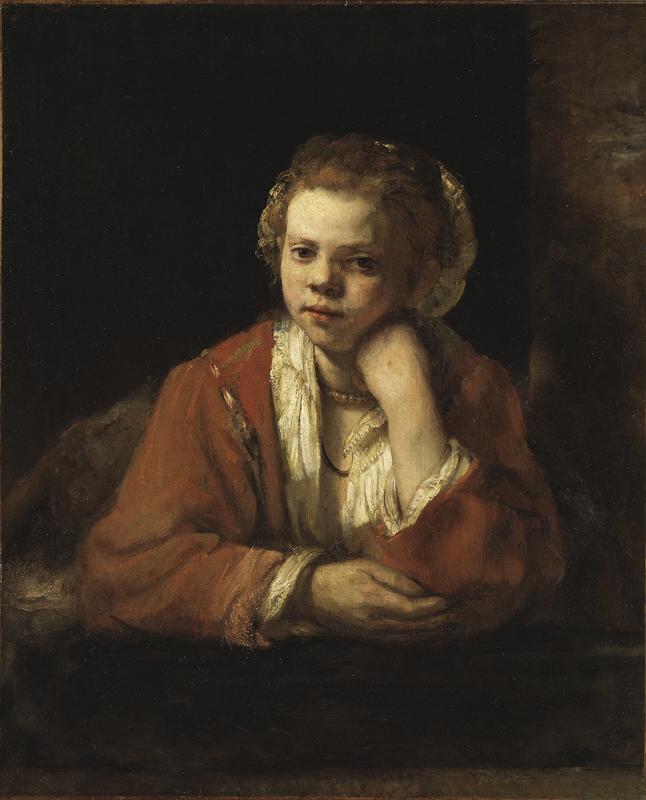More about The Kitchen Maid

Contributor
An apocryphal old yarn tells us that Rembrandt used to place The Kitchen Maid so that it was visible from the street, either in the window or on the outside of the house, and passers-by would mistake it for an actual person.
This effect, as Thomas Fahlander tells the story, functioned as a kind of advertisement for the artist, who certainly needed the dough. Around a year before he finished this work he stopped paying mortgage on the house as he could no longer afford it. This was a rude awakening, to realize he was living beyond his means. Two years later, the money-lending chickens came home to roost, and Rembrandt received a bill for his debt, which would eventually lead him to downgrade to a more modest pad.
Nine years before Rembrandt finished this painting, the death of his wife, Saskia van Uylenburgh, left the artist the single father of an infant son. Lickety split, he hired (and then shacked up with) a widow named Geertje Dircx, who stayed with them for seven years. Things didn't work out, maybe because of all the prostitutes who moonlighted as nude models in Rembrandt's Rolodex, but more likely because of his relationship with his housekeeper, Hendrickje Stoffels. Dircx took Rembrandt before the Commissioners of Marital Affairs, accusing him of breaching his promise to marry her, the laws of which were designed to prevent men from cohabiting with women to whom they were not wed. Rembrandt offered Dircx a stipend of sixty guilders per year for the rest of her life, on the condition that she keep Rembrandt's son Titus as her sole heir, but they still couldn't reach an agreement, because Dircx said that it wouldn't cover her if she fell ill. Soon enough, near the exact moment that Rembrandt was producing The Kitchen Maid, he had the authorities commit Dircx to the women's prison in Gouda for twelve years. After five years in the pen, Dircx made an admirably gutsy attempt to sue the famous Rembrandt for false imprisonment.
In the 1670s, this painting belonged to Count Johan Gabriel Stenbock, whose tomb was sculpted by Bernard Foucquet the Elder. In 1861, when the Swedes added it to the inventory of the National Museum, this work was titled Portrait of a Young Woman in Red Sweater, but, less than a century earlier, she was presumed to be a young man. When Swedish monarch Gustav III purchased this work from the estate of Eva Bielke, daughter of Count Carl Gustaf Bielke, in 1779, its title was the Study of a Boy Supporting his Head in his Hand.
In 2019, chemists working in concert with the Rijksmuseum discovered the star of Rembrandt's show, an essential key to the magic of light and shadow in his works. It's a chemical compound, containing highly dangerous white lead, called "plumbonacrite," and if you, unlike me, chose to take chemistry in high school instead of posting on message boards and playing video games, you might also understand this phase label describing its structure: Pb5[CO3]3O[OH]2.
Sources
- Cavalli-Björkman, Görel. Rembrandt and his age. Stockholm: Nationalmuseum, 1992.
- Crenshaw, Paul. Rembrandt's Bankruptcy: The Artist, His Patrons, and the Art World in Seventeenth-Century Holland. Cambridge: Cambridge University Press, 2006.
- Driessen, Christoph. Rembrandts vrouwen. Amsterdam: Prometheus BV Vassallucci, Uitgeverij, 2001.
- Fahlander, Thomas. "Utan titel!" Språk Tidningen, Apr. 2012, https://spraktidningen.se/artiklar/2012/05/utan-titel.
- Gonzalez, Victor, Marine Cotte, Gilles Wallez, Annelies van Loon, Wout de Nolf, Myriam Eveno, Katrien Keune, Petria Noble, and Joris Dik. "Unraveling the Composition of Rembrandt's Impasto through the Identification of Unusual Plumbonacrite by Multimodal
- van der Piet, Sebastiaan. "The presentation of Christoffel Thijsz. ' bill for Rembrandt's debt on his house (4 February 1653)." RemDoc, http://remdoc.huygens.knaw.nl/#/document/remdoc/e4629.
- White, Christopher, Edwin Buijsen, and Quentin Buvelot. Rembrandts Selbstbildnisse. Stuttgart: Belser, 1999.
Featured Content
Here is what Wikipedia says about The Kitchen Maid (Rembrandt)
The Kitchen Maid (1651) is an oil-on-canvas painting by the Dutch painter Rembrandt. It is an example of Dutch Golden Age painting and is now in the collection of the Nationalmuseum in Stockholm, Sweden.
This painting was documented by Hofstede de Groot in 1915, who wrote:
330. A YOUNG GIRL AT A WINDOW, IN FULL FACE. Sm. 506.; Bode 365; Dut. 315; Wb. 440; B.-HdG. 397. She leans her right arm on the window-sill and rests her head on her left hand. She wears a dull red jacket. Her dark hair is combed back into a small golden-yellow cap. The loose chemisette is slightly open at the throat, showing a string of pearls and a little black ribbon hanging down on the bosom. Dark background; the figure is lighted from above to the left. Half-length, life size. Formerly known as "La Crasseuse." Signed in the centre at foot, "Rembrandt f. 1651"; canvas, 31 inches by 25 inches. Etched by L. Loewenstam. Mentioned by Bode, pp. 504, 606; by Dutuit, p. 40; by Michel, pp. 394, 568 [304-5,442]; by Roger de Piles, 1715 edition, p. 423; by Granberg, Inventaire Génerale, iii. No. 297. In the collection of Roger de Piles, Paris. In the collection of Duvivier, Paris. In the collection of the Comte d'Hoym, Paris. In the collection of De Morville, Paris. Sales. Angran de Fonspertuis, Paris, March 4, 1748, No. 435 (2001 francs, with 203, "Flora," Blondel de Gagny). Blondel de Gagny, Paris, December 10, 1776, No. 70 (6000 francs); it was then rounded at top and measured only 32 inches in height. Duc de Lavalliere, Paris, February 21, 1781 (5500 francs, with pendant, 467/7); see C. Blanc, ii. 43. In the collection of Gustavus III., King of Sweden. In the Stockholm National Museum, 1900 catalogue, No. 584.
Other "Kitchen Maid" paintings by Rembrandt or his school are:
-
Rembrandt workshop, National Gallery of Art
-
Rembrandt, Dulwich Picture Gallery
Check out the full Wikipedia article about The Kitchen Maid (Rembrandt)












